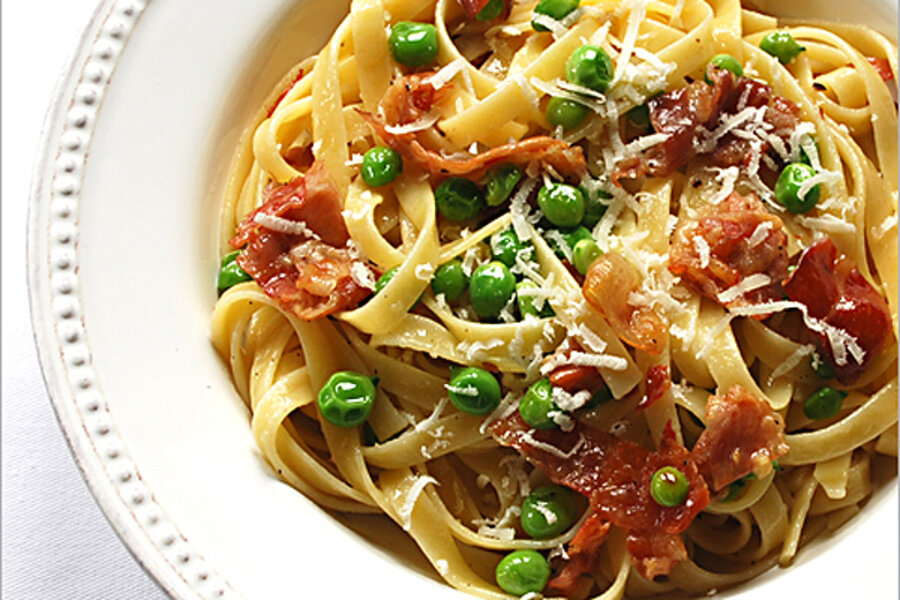Quick and creamy: Pasta with peas, prosciutto, and Parmesan
Loading...
The hardest part of cooking with fresh English peas, at least for us, is getting the peas home from the produce market. Typically, I will be driving, and Marion will be shelling peas, alternately feeding me handfuls and devouring them herself. By the time we arrive home, we’re left with nothing but a bagful of empty pea pods. But I was determined to make this pasta dish, so the peas rode safely home in the trunk this time.
Interestingly though, the ritual above is what awoke me to the wonder that is fresh peas. I grew up eating (or more accurately, avoiding) canned peas. And even when I “graduated” to frozen, I remained unimpressed. They still had that same one-dimensional, disconcertingly sweet flavor and a wrinkly, mushy, nothing texture.
Fresh peas, on the other hand, are a whole other animal, er, vegetable. Eaten raw straight from the pod, they have a nice, crisp snap to them and a sweetness that is much more subtle. They are vibrant and lively and conjure up visions of springtime, not cafeteria ladies. In making this pasta dish, I was determined to cook them as little as possible – to just warm them, really – to retain that wonderful freshness.
A quick peas primer: There are three basic kinds of green peas. English peas, also known as garden peas and fresh peas, come in plump pods and must be shelled. It’s quite easy – just squeeze the pods along the seams and they readily split open. It’s nothing like the involved, two-step process of shelling fava beans. Sugar snap peas and snow peas have edible pods. All three are legumes, actually related to peanuts.
Fettuccine with peas and prosciutto
Serves 4
1 tablespoon olive oil (plus extra)
1/4 pound thinly sliced prosciutto, roughly chopped
1 clove garlic, minced (or 1 shallot or small yellow onion, finely chopped – see Kitchen Notes)
1-1/4 to 1-1/2 cups shelled fresh English peas, from 1-1/2 pounds unshelled peas (or frozen peas – see Kitchen Notes)
1/4 cup heavy cream
Salt and freshly ground black pepper, to taste
Freshly grated Parmesan
16 ounces fettuccine or other ribbon pasta, cooked according to package instructions
1. Shell the peas, then start a pot of water for cooking the pasta as you prep the rest of the ingredients. When the water is boiling, start the pasta and heat a large skillet over a medium flame. Add 1 tablespoon of oil, then the prosciutto, tossing to coat with oil and separate the pieces. Cook for about 3 or 4 minutes, reducing the heat if it starts to smoke. Add garlic to pan and cook until just fragrant, about 45 seconds. Add peas and toss to mix ingredients. Sauté for 1 or 2 minutes, then add cream. Toss to coat prosciutto pea mixture. The cream will pretty much disappear into the dish.
2. Drain fettuccine and add most of it to the pan. Toss to combine. Add the rest of the fettuccine gradually, making sure it doesn’t overwhelm the other ingredients – if it starts to, discard the remaining pasta. If pasta is dry (mine was), drizzle with extra olive oil and toss to coat. Divide among 4 shallow bowls, using tongs to pick up pasta. Much of the prosciutto pea mixture will remain behind in the pan. Use a spoon to top each serving of pasta with it. Grate some fresh Parmesan over each bowl and serve.
Kitchen Notes
So how was it? Different than I expected, in a good way. I pretty much invented this after seeing a couple of springy pastas on magazine covers. I didn’t expect the cream to disappear into the dish as much as it did, but that turned out to be good, too – it wasn’t a creamy, soupy dish, but it had the subtle richness of the cream. And the saltiness of the prosciutto and slight sharpness of the garlic nicely balanced the peas’ sweetness. All in all, it was less delicate and “mumsie, dear” than I feared it might be.
Garlic, onions, something. I used garlic, a good choice, I think, to balance the sweetness of the peas and richness of the cream’s flavor. You could also use a finely chopped shallot or small yellow onion.
Fresh is best. If at all possible, use fresh peas for this dish. If you can’t get them, frozen is next best, having much less sodium than canned. Add the frozen peas to the cooking pasta a couple of minutes before it’s done.






